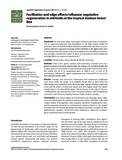Mostrar el registro sencillo del ítem
Facilitation and edge effects influence vegetation regeneration in old-fields at the tropical Andean forest line
| dc.rights.license | http://creativecommons.org/licenses/by-nc-sa/3.0/ve/ | |
| dc.contributor.author | Bueno, Andrea | |
| dc.contributor.author | Llambí, Luis Daniel | |
| dc.date.accessioned | 2015-09-18T19:45:53Z | |
| dc.date.available | 2015-09-18T19:45:53Z | |
| dc.date.issued | 2015 | |
| dc.identifier.uri | http://www.saber.ula.ve/handle/123456789/40830 | |
| dc.description | Applied Vegetation Science 18 (2015) 613-623 | es_VE |
| dc.description.abstract | Questions: Do local plant-plant interactions and facilitation play an important role in vegetation dynamics after disturbance in the high tropical Andes? In particular, does the dominant shrub Baccharis prunifolia have an effect on microclimate and local vegetation structure within old-fields at the upper forest line? Does distance from the border of the surrounding forests also influence community structure within fallow plots? Is there an interaction between facilitation and edge effects on vegetation regeneration? Location: Gavidia Valley, Sierra Nevada de Mérida, Venezuela. Methods: Plant cover, species richness and community structure were compared in circularmicro-plots placed under the canopy of B. prunifolia shrubs and in open areas (12micro-plots in each case) both near and far fromthe forest border within two 10-12 yr successional plots at 3400 m a.s.l. (a total of 96 micro-plots). Additionally, topsoil temperature was monitored for 1 mo in the four situations under study. Results: Average and maximum temperature and temperature amplitudes were lower under the canopy of B. prunifolia shrubs than in open areas; this effect being more marked far from the forest edge. Species richness, vegetation cover and the density of dominant forest trees were higher under the shrubs’ canopy than in the inter-shrub spaces. The proximity to the edge of the surrounding forest also had a positive effect on species richness, with no significant interaction with the local sampling situation (under shrub vs outside). Conclusions: Our results suggest that both facilitation and edge effects influence the effectiveness of vegetation regeneration within old-fields in the high tropical Andes. Consequently, these processes should be considered for interpreting vegetation dynamics in environmental change scenarios at the tropical mountain tree line and for the design of ecological restoration strategies in these high-diversity ecotones, which have been subjected to large-scale anthropogenic transformations in recent decades. | es_VE |
| dc.language.iso | en | es_VE |
| dc.rights | info:eu-repo/semantics/openAccess | |
| dc.title | Facilitation and edge effects influence vegetation regeneration in old-fields at the tropical Andean forest line | es_VE |
| dc.type | info:eu-repo/semantics/article | |
| dc.description.colacion | 613-623 | es_VE |
| dc.description.email | abuenog@gmail.com | es_VE |
| dc.description.email | llambi@ula.ve | es_VE |
| dc.publisher.pais | Alemania | es_VE |
| dc.subject.facultad | Facultad de Ciencias | es_VE |
| dc.subject.institucion | Universidad de Los Andes | es_VE |
| dc.subject.keywords | Heterogeneity | es_VE |
| dc.subject.keywords | Microclimate | es_VE |
| dc.subject.keywords | Páramo | es_VE |
| dc.subject.keywords | Plant-plant interactions | es_VE |
| dc.subject.keywords | Secondary succession | es_VE |
| dc.subject.keywords | Species richness | es_VE |
| dc.subject.keywords | Tree establishment | es_VE |
| dc.subject.thematiccategory | Biología | es_VE |
| dc.subject.tipo | Artículos | es_VE |
| dc.subject.unidadinv | Instituto de Ciencias Ambientales y Ecológicas (ICAE) | es_VE |
| dc.type.media | Texto | es_VE |
Ficheros en el ítem
Este ítem aparece en la(s) siguiente(s) colección(ones)
-
Articulos, Pre-prints (Facultad de Ciencias)
-
Articulos, Pre-prints (Instituto de Ciencias Ambientales y Ecológicas (ICAE))
Articulos, Pre-prints del Instituto de Ciencias Ambientales y Ecológicas (ICAE)


